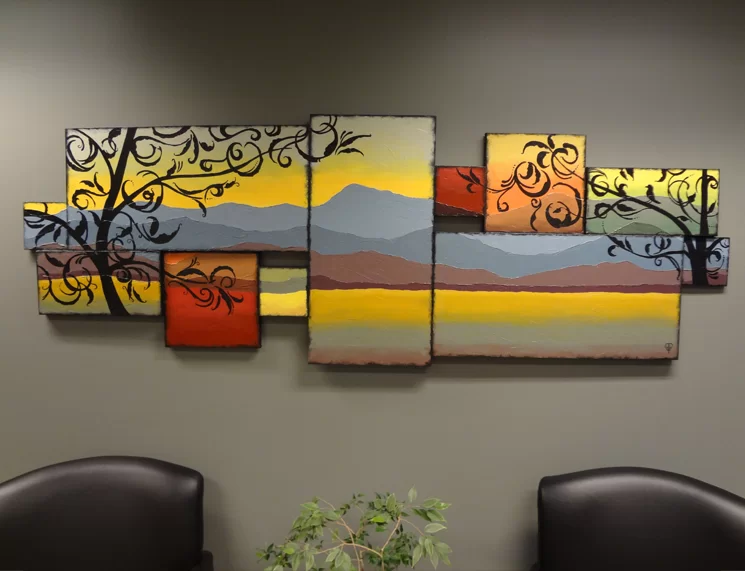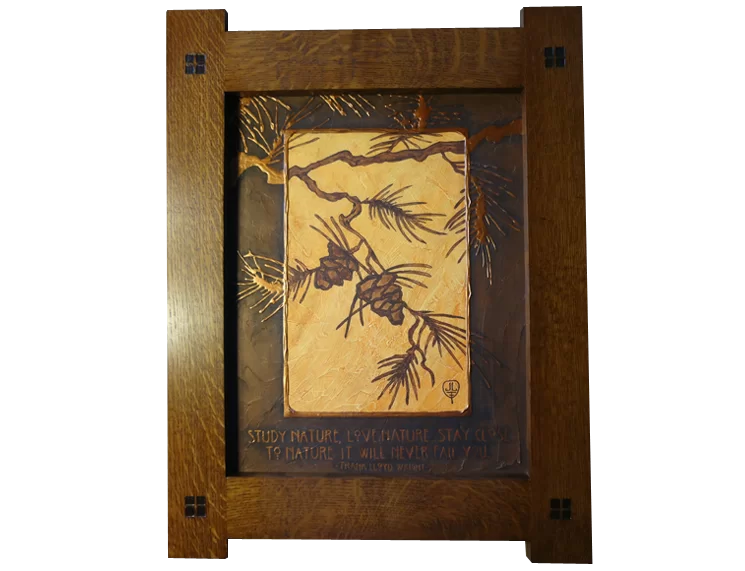A Painter’s Purpose: Julie Leidel of The Bungalow Craft
by Kate Nixon
One of my favorite things to do when writing about an artist is to view their website. I love asking questions and getting to know the story behind the person. But truth be told: I’ve always been a fan of beautiful and well put together websites and an artist website will often send me into a flurry of waves of visual inspiration for my own. Julie Leidel’s website is just lovely and you get an immediate sense of her love of Colorado and her art a few seconds in. The sweet photo of her embracing her son amidst a picturesque view of the hike-worthy Colorado Mountains stood out on her artist bio page. A picture outlining the Roycroft Renaissance stands off to the left, declaring Leidel as a Roycroft Renaissance Artisan and the process of becoming one looks official and and yet the picture of mother and child embracing with the mountains as a backdrop is still just as compelling and catches my eye.
Within the many art pieces I’ve had the privilege to experience in the Arts & Crafts movement, a great majority – if not all – pay tribute to the great outdoors and I’ve no doubt gotten the point that to be a dedicated Arts & Crafts artist or supporter is to have a deep respect of the majesty of the natural world. Even as I write this, I’m staring at a poster for the 2017 Arts and Crafts Conference – a poster for which Leidel did the art. It’s an assortment of brown and green painted trees and high above in the dark foliage, I spot the familiar bright russet tone of the iconic Grove Park Inn roof. Her love of nature – both as a subject and enjoying it in her own time – is evident and my eye turns to the latest Conference poster art of hers.
Over the summer, we chose Leidel to create our 2020 Conference poster art – you can see the poster art at the bottom – but I wanted a deeper look into the painter’s life. Julie Leidel took some time to answer a few questions about what inspires her, what a day in her life is like, and what recent project she’s most proud of.
I realized that I wanted to show my daughter as she grew that a mom could be a great mom and still follow her passion in a career. – Julie Leidel
Julie Leidel fell in love with drawing and painting early in life – her mother was a crafter, quilter, and painter so she had grown up around the materials and processes. In high school, she would keep up with art classes, but when college came, she chose a different path. “I didn’t trust my heart at first,” she said. “I went to Colorado State University and studied for a year to become a Mechanical Engineer. After my freshman year, I realized I wasn’t being true to myself and where my heart was at.” She changed her major to Graphic Design and took extra painting classes to stay in the studio. She worked full-time in the e-learning industry as a UI designer, photographer, and creative lead for 15 years. When she had her first child in 2008, she fully realized her artistic core and came to a powerful realization. “I realized that I wanted to show my daughter as she grew that a mom could be a great mom and still follow her passion in a career. 2013 was the year I could successfully change careers completely and I’ve been so happy and proud of myself for keeping that fire inside alive and honoring my personal path to fulfillment.” The rest is history.

Costa Brava: Gouache on illustration board. 24″ x 20″. Picture courtesy of https://www.thebungalowcraft.com.
What designs inspire you?
My husband Brian and I fell in love with the Arts & Crafts Movement in 2004. We were living through a huge home remodel at the time, and Brian brought home a few books like Bungalow Nation to show me. We both fell in love with the movement right then and there. My library has grown considerably since then to include books with all my favorite art movements: Arts & Crafts, Art Nouveau, Vienna Secession, Jugendstil, Art Deco, and the WPA era of the American 1930s-1940s. I fell in love with everything from the furniture, to the ceramics, to the lighting, leather, metal work, and stained glass.
What is a typical day like for you?
From May to September each year, I work about 80-100 hours a week. Mind you, I feel like I’ve already “retired” so it doesn’t feel like work as much, but the hours can’t lie. I’m packing my SUV up each with for a different fine art festival usually in a different Colorado mountain town. I spend a lot of time fulfilling orders and commission paintings, keeping my show inventory up, buying supplies, matting prints, and selling my work. I’ve created my own website and I manage all my own marketing and SEO work. There are so many hats to wear as an entrepreneur that it’s amazing how little time is devoted to actual painting sometimes. During the busy season, I may only spend 2-6 hours a week on new work if I’m lucky. Some weeks I never even get the paints out. Most of my painting time is during the off-season from October to April.
With so many advances in technology for artists, what do you do in your process to keep the “head, heart, and hand” philosophy going?
As an artist, I have many tools at my disposal: pencils, pastel chalks, paint brushes, palette, and exacto knives are the tools I use all the time. My computer, Wacom tablet, light table, and even my phone are also tools that I use regularly. These tools would all just sit idle if it weren’t for the artist putting them to use. When I think about the philosophy written by John Ruskin, that “Fine art is that in which the hand, the head, and the heart of man go together,” I feel greatly inspired by his words because it can be easy to get out of balance and use too much of one of those attributes. My best work comes from taking my time to balance all three areas and explore my heart first: subject-matter, research, history, and inspirational art movements. My head second: the composition, typography, and color theory, and then finally my hand: through paint, my brushes, my temperament and my working style.
I love painting because I can connect with another human being in a deep and powerful way quickly, but this connection can last a lifetime. – Julie Leidel

Myer’s Landscape: Acrylic on multiple canvases. 16 ft x 4 ft. Picture courtesy of https://www.thebungalowcraft.com
Tell me about a project you are currently proud of.
I was commissioned by the Civic Center Conservancy in Colorado to create a 100th anniversary painting for our Civic Center park, and the Greek Theater, which was created in 1918 and finalized in 1919. I wanted to invest my heart by first learning as much as I could about the history of the park. I stumbled upon an amazing American artist that was commissioned for hundreds of murals all around Colorado and the West – Allen Tupper True. He was commissioned for work in the park, and in our state capitol as well as the state capitols in Wyoming and Missouri. His work pulled my heart in ways I wasn’t expecting and I went on a sojourn to visit all the murals that I could find still standing in Denver. I love his Native American and Frontiersman subject matter, his color palette, style, and the lens in which he wants you to view his work. I call it the “True Light.” In my Civic Center painting, I wanted to capture our modern landscape and how it’s changed over the last 100 years, but to also pay homage to a great American artist that most definitely should be included in the master list of Arts & Crafts artists from the era.
What do you love most about painting?
I love the freedom that anything under the sun can be created. I can pull concepts from philosophy, history, nature, and science. I can pull from beliefs and emotion. I can tell a story through art that wasn’t there before to bring the art lover back in time to explore their own memories, or to touch on something that feels generationally inherited. I love painting because I can connect with another human being in a deep and powerful way quickly, but this connection can last a lifetime.

Wright – Nature: Acrylic on pressed board. 12″ x 18″ with custom quartersawn oak frame. Picture courtesy of https://www.thebungalowcraft.com.
You were awarded the title of Roycroft Renaissance Artisan in 2016. What does it mean to you to be a Roycrofter?
In order to be accepted as a Roycrofter, the following five criterion are at the core of how each artist is measured: High quality hand craftsmanship, excellence of design, originality of expression, professional recognition, and artistic growth. I’m honored to currently be one of about 72 artists around the nation that have been accepted to this prestigious group, continuing on in the same spirit of the Arts & Crafts Movement. The Roycroft Renaissance Double-R trademark can be found on my original paintings since my acceptance as a Roycroft Renaissance Artisan.
As promised, here’s the 2020 Conference Poster art as created by Julie Leidel…

Visit Julie Leidel’s website, The Bungalow Craft, here at https://www.thebungalowcraft.com
